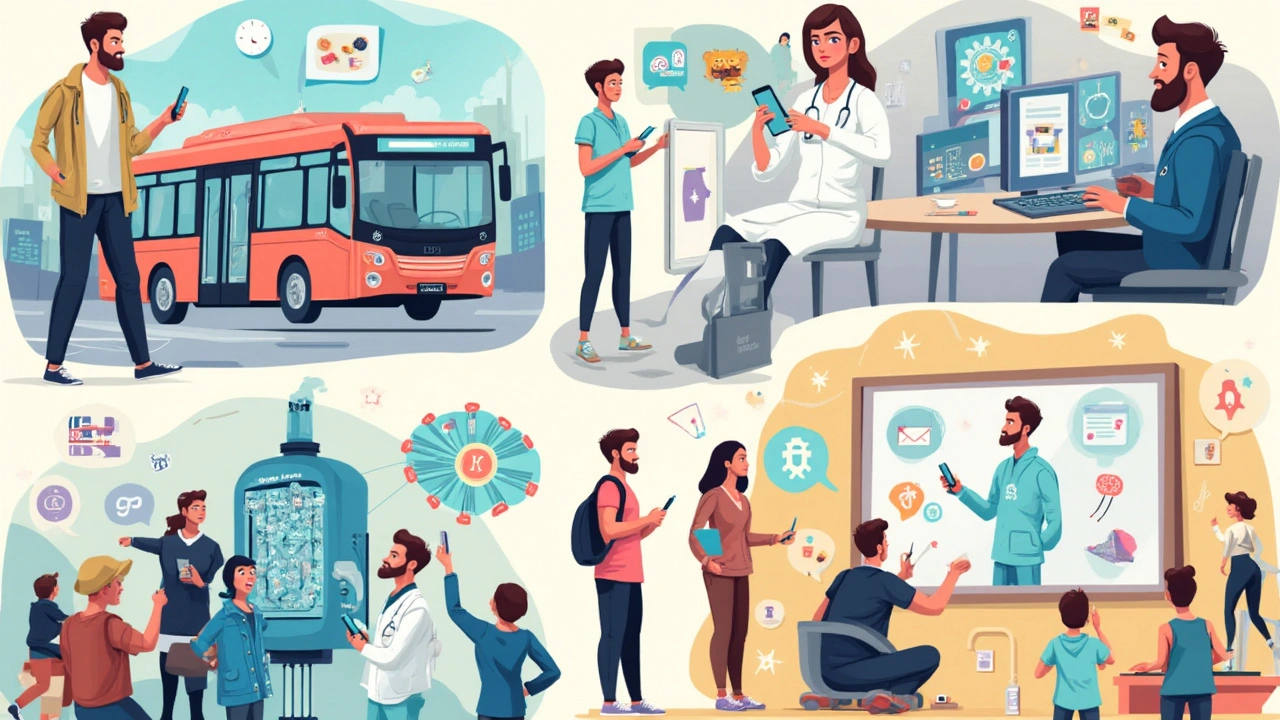Think about how much tech has changed in the last five years. AI is the main reason. It isn’t just powering chatbots or robots; it’s running your phone, filtering your emails, and even picking your next Netflix binge. If you know how to code for AI—even a little—you’re not just along for the ride. You’re driving.
Getting started can feel intimidating. Python? TensorFlow? Fancy terms fly around like confetti. But the truth? Most folks underestimate how much you can do with just the basics. You don’t need a PhD to build stuff that actually works. Some of the biggest breakthroughs started with starter projects, a handful of tutorials, and plenty of trial and error.
If you know basic coding, you already have a head start. AI coding is more about mindset than memorizing commands. Think of it like giving your computer a curious brain. Instead of telling it exactly what to do, you teach it how to figure things out—kind of like how you learned to ride a bike by wobbling until it clicked.
- Why AI Coding Matters Now
- The Skills You Actually Need
- Real Projects: Where AI Meets Everyday Life
- Tools, Frameworks, and Shortcuts
- Pro Tips for Faster Learning
Why AI Coding Matters Now
If you look at how tech jobs and products have evolved, you’ll realize this is the best time in history to dive into coding for AI. Machine learning is no longer some science fiction buzzword. In 2024, according to Stack Overflow’s annual survey, over 40% of professional developers used AI tools weekly. That number isn’t slowing down. Companies—big and small—are desperate for people who can teach software to learn and adapt.
What’s wild is how many everyday things now run on AI models. Your shopping app’s product suggestions? AI. Spam filters? That’s AI, too. Doctors use AI to analyze scans faster than ever. Law firms use it for digging through piles of case files. The workplace is shifting, and hiring managers want folks who can automate and innovate, not just code the old way.
If salary matters—and let’s be honest, it usually does—a U.S. Bureau of Labor Statistics update in April 2025 showed that machine learning engineers earned a median salary of $157,000. Regular programmers average about $106,000. That gap is only getting bigger as companies put more money into smarter products.
Here’s a quick look at how AI coding is popping up in major industries:
| Industry | Common AI Use | Real-World Example |
|---|---|---|
| Healthcare | Image analysis, diagnosis, patient prediction | AI reading X-rays at Mayo Clinic |
| Finance | Fraud detection, algorithmic trading | JPMorgan Chase’s fraud alerts |
| Retail | Recommendation engines, chatbots | Amazon's "Customers Also Bought" |
| Automotive | Self-driving systems, preventive maintenance | Tesla Autopilot |
The bottom line—people who can shape AI aren’t just in demand; they’re shaping how the world works. If you want your tech career to be future-proof, picking up some AI skills is almost a no-brainer.
The Skills You Actually Need
Let’s be real—most guides make coding for AI sound impossible. The truth? You don’t need 20 years of experience or a suitcase full of math degrees. But there are a few non-negotiable skills you’ve got to lock down if you want things to click.
- Python: This is the go-to language for coding for AI. It’s simple, readable, and has mountains of libraries for machine learning and data science. If you know your way around basic Python syntax, you’re off to a strong start.
- Math Basics: You don’t need PhD-level math, but you should be comfortable with algebra and basic statistics. Stuff like probability, mean, median, and standard deviation actually matter. Want to understand why a model is making weird predictions? A pinch of math helps.
- Understanding Data: AI runs on data. If you know how to clean data, find weird patterns, or spot problems, you’ll make way fewer mistakes. Skills with tools like pandas or even just Google Sheets count here.
- Curiosity and Patience: Not a joke. You’ll spend time debugging or reworking things that just won’t learn properly. If you’re the type who likes breaking stuff and figuring out why, you’ll fit right in.
- Version Control: Git isn’t just for pros. It lets you experiment without wrecking your main project. Learning the basics of Git (commit, push, pull, branch) will save you a ton of grief.
Don’t just take my word for it—check out this quick breakdown of what most entry-level AI jobs actually ask for. You’ll notice flashy skills like “deep learning” or “natural language processing” don’t always make the cut. Work on the basics first.
| Skill | % of Entry Jobs Mentioning |
|---|---|
| Python | 92% |
| Data skills (pandas, cleaning) | 78% |
| Basic statistics | 65% |
| Version control (Git) | 53% |
| Deep learning (TensorFlow, PyTorch) | 28% |
The numbers don’t lie. Focus on building your foundation—specialties come later. And if you hit a wall? Don’t panic. Every pro coder started by Googling stuff and learning through trial and error. That’s just how you get better.

Real Projects: Where AI Meets Everyday Life
If you think coding for AI is only for researchers at NASA or Silicon Valley giants, you’re missing out. AI has crept into day-to-day stuff people barely notice. For starters, that phone camera that blurs your background perfectly during video calls? That’s AI trained with image recognition. Or, take Gmail’s smart reply—those automatic, one-tap responses came from basic natural language models anyone can now tinker with.
AI projects don’t have to look like sci-fi. Here are some real examples people can build or improve without a supercomputer:
- AI Personal Assistants: You can code your own version of a voice assistant that recognizes commands, plays music, sets timers, or reminds you about appointments. Free APIs like OpenAI's Whisper or Google Speech help kickstart these.
- Smart Home Tweaks: Folks add machine learning to smart lights or thermostats—letting their gadgets learn when to turn things off, just by logging when people are home. Simple motion sensors, an afternoon with Python, and it’s running.
- Spam and Scam Filters: You don’t have to work at a big company to make your own email filter. Training a basic model on your own inbox sets up a custom system that blocks shady stuff way better than generic filters.
- Fitness Apps: People are coding AI that corrects your yoga pose or counts your push-ups using only your phone’s camera. TensorFlow Lite makes it possible right on your phone—no cloud servers needed.
One thing that surprises most beginners is how often open datasets and pretrained models can jumpstart a project. You don’t have to collect your own mountain of data. Sites like Hugging Face or Kaggle are goldmines for free stuff to use and remix. Adoption rates for these tools have exploded—more than 30% of all new AI projects on GitHub in the past year started with pretrained code or data.
The best way to get the hang of AI isn’t to just read about it. Pick a project you care about, grab a dataset, and break things until something clicks. You’ll learn faster, stay motivated, and maybe even build something people want to use.
Tools, Frameworks, and Shortcuts
Don’t get stuck thinking you need to build everything from scratch. A huge chunk of AI coding is just knowing the right tools to speed things up. The heavy lifting is handled by open-source frameworks and pre-built libraries. This means you mostly get to focus on the fun part—solving actual problems.
Let’s get the big names out of the way. If you’re starting out, you’ll want to use Python for almost everything related to coding for AI. It’s simple, flexible, and has way more community support than other languages. Two powerhouses—TensorFlow (from Google) and PyTorch (mainly backed by Meta)—dominate deep learning projects. Both have enormous documentation, tons of tutorials, and huge communities willing to help out on forums like Stack Overflow. Keras is another one, and it basically simplifies TensorFlow, making high-level model building way less confusing.
If you’re more into classic machine learning instead of deep learning, check out Scikit-learn. It’s clean, easy to understand, and great for projects like predicting house prices or classifying spam emails. For data cleaning and wrangling, Pandas is a must-have. Jupyter Notebook makes it easy to test ideas and visualize results step-by-step.
Here’s a quick rundown of the most popular and accessible tools for wannabe AI coders:
- Python — go-to language for pretty much every AI project
- TensorFlow & PyTorch — top picks for deep learning tasks
- Keras — high-level interface that simplifies building neural nets
- Scikit-learn — perfect for traditional machine learning
- Pandas — lets you wrangle data like a pro
- Jupyter Notebook — makes code testing/visualization effortless
You might wonder how these choices stack up when it comes to real use. Here’s a straight-up comparison of their popularity based on GitHub stars (as of April 2025):
| Framework/Tool | GitHub Stars | Main Use |
|---|---|---|
| TensorFlow | 174K | Deep Learning |
| PyTorch | 92K | Deep Learning |
| Scikit-learn | 59K | Machine Learning |
| Pandas | 41K | Data Preparation |
| Keras | 61K | Model Prototyping |
A little hack for speeding up practice: Google Colab is like a cloud laptop that lets you run code without buying a beefy PC. You just need a browser. Tons of free GPU hours help you train bigger models before your wallet feels the burn. No installation headaches, no setup drama.
Pro tip: Don’t be afraid to copy code, tweak it, and see what breaks. Most real-world AI projects start by reusing open-source examples and slowly customizing as you learn. That’s not cheating—that’s smart.

Pro Tips for Faster Learning
If you want to really speed up your journey into AI coding, you need to cut the fluff and use what works. I’ve watched folks waste months memorizing theory, only to freeze when it’s time to build. The trick? Center your time around hands-on work and staying plugged into the right resources.
- Stick With One Language: Python is your friend. All the top AI libraries use it, and jobs often ask for it. There’s no point splitting your focus early on.
- Use Real Datasets: Don’t just read documentation. Download datasets from Kaggle or UCI Machine Learning Repository and mess with them. That’s what hiring managers want to see, too.
- Join Coding Communities: Reddit’s r/MachineLearning, Stack Overflow, and Discord groups are full of folks helping each other troubleshoot bugs or brainstorm ideas. Others’ real mistakes and solutions can teach you more in a day than a week of reading textbooks.
- Build Mini Projects: Skip the generic “hello world” samples. Try a spam filter for your email or an image recognizer for your pet photos. You learn way faster when solving personal annoyances.
- Read Code, Not Just Tutorials: Find the source code of popular AI projects on GitHub and poke around. You’ll pick up tricks the pros don’t even mention in articles.
Another thing most people miss: review your progress regularly. Weekly check-ins work best. Ask yourself and your community, “What did I actually build this week?”
Here’s a quick look at how long people typically take to get job-ready with coding for AI:
| Learning Style | Average Time to Build First AI Project | Time to First Job/Internship |
|---|---|---|
| Only Online Courses | 3-5 months | 12+ months |
| Online Courses + Projects | 2-3 months | 6-9 months |
| Bootcamp/Full-Time Immersion | 1-2 months | 3-6 months |
If you’re in a hurry, focus on building, sharing, and asking for feedback every week. The more you build, the less you’ll get stuck. That’s what separates folks who dream about AI from the ones who actually get paid for it.

